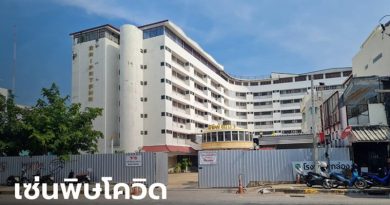Thailand’s EEC project to boost GDP beyond 5%
THAILAND stands to benefit a great deal in terms of future economic growth from its timely launching of its long term national strategy and Eastern Economic Corridor (EEC) project, which, thanks to US President Donald Trump, will unexpectedly benefit from the relocation of industries from China.
The launch of the country’s major development project called Eastern Seaboard industrial development by the Junta government led by Prime Minister Gen Prem Tinsulanonda back then over 30 years ago had unexpectedly led to the country’s economic boom for over a decade with foreign investment pouring into the area.
During the past three decades, Thailand had never launched any major development project and that has resulted in the country’s GDP being lower than 5% during the past several years with foreign investment going elsewhere as the country had faced with internal political problems.
The lacking of any long term development plan especially in the industrial and infrastructural area is seen by some as a blessing in disguise.

While many countries might have invested in the traditional industrial development which more or less have met with drastic technology disruptions, making it costly and difficult to change, Thailand’s latest 4.0 plan and EEC project launched by another Junta government, this time led by Prime Minister Prayut Chan-o-cha, is considered very timely.
“This is considered a new S-curve for the Thai economic and industrial development, which will bring back direct foreign investment (FDI) and economic growth beyond 5% per annum again in the near future,’’ said an economist.
Regional wise, Thailand’s development plan would also benefit from China’s One Belt One Road development project as Thailand is considered a region hub location wise.
Prime Minister Prayut last week said if Thailand is to escape the middle-income trap and transforms into a high-income nation, it has to stick to the 20-year national strategy and EEC project.

The government has spent the last four years boosting GDP growth from 0.8% in 2014 to more than 4% by the end of this year. So we need the framework for the next 20 years to ensure continuity, he said.
The government expects the EEC to boost private investment to a 10-year high in 2019, catalyzed by investment in infrastructure and the ten targeted industries, namely, the next-generation automotive industry, the intelligent electronics industry, the advance agriculture and biotechnology, the food processing industry, high wealth and medical tourism industries, digital industry, the robotics industry, aviation and logistics industry, comprehensive healthcare industry, biofuel and biochemical industries.
Kanit Sangsubhan, secretary-general of the EEC Office is optimistic that private investment is anticipated to increase by 10% in 2019, given a GDP growth expected to expand by 5%. The EEC is a key factor to drive the economy forward, following the Eastern Seaboard project’s development as a center for export-oriented industries. Private investment expanded by 3.4% in the first quarter of this year and investment has recorded continuous expansion for three consecutive years.
In the past 10 years, Thailand’s private investment and FDI expanded by an average of only 3% per year, with the country’s GDP growth expanding by the same rate,” said Mr Kanit. Public infrastructure investment projects such as the Laem Chabang and the Map Ta Phut deep-sea port project will be launched within this year.

The EEC project has been planned to garner investment worth more than 1.7 trillion baht over 2017-21.
The EEC project will, initially, be focused in three eastern provinces namely Chachoengsao, Chonburi and Rayong and has five promotional zones, namely, the Special EEC Zone: Eastern Airport City, the Eastern Economic Corridor of Innovation: EECi, the Digital Park Thailand: EECd, and the Smart Park Hemaraj Eastern Seaboard Industrial Estate
In addition, several important transportation infrastructure development projects have been approved and include: studies of rail systems, which will connect Don Muang, Suvarnabhumi, and U-Tapao International Airports.
Co-incidentally, electronics makers are now preparing to shift from China to Thailand as trade tensions with the US make it less appealing to manufacture gadgets in China.
According to a report to the Stock Exchange of Thailand last week, Delta Electronics Inc., which supplies power components to Apple Inc., said it’s making a $2.14 billion offer to buy out a Thai affiliate, Delta Electronics (Thailand) — a precursor to expanding production here.
Merry Electronics Co., which makes headphones, said it may also move some of its production to Thailand from southern China, depending on how the trade conflict pans out.
New Kinpo Group, which makes everything from computer hardware to facial massagers in Thailand and the Philippines, told Bloomberg this month that Donald Trump’s offensive was spurring growing interest in its services.
There are a lot of uncertainties in geopolitics and the China-US trade war has begun,” Delta Chairman Yancey Hai told reporters. The company also addressed the Thai deal saying Delta, with the acquisition, can add more manufacturing bases, reduce risks brought about by the global trade war, bolster its sales network and get closer to its customers.
Delta is preparing to move its semi-finished products from China to Thailand first and finish final assembly there if tariffs hit.
CAPTIONS:
Top: The Map Ta Phut industrial estate in eastern Rayong province. Photo: Reuters/Sukree Sukplang via Asia Times (atimes.com)
First and second in-text: Charts from the Industry Ministry showing EEC’s huge potential.
Third in-text: An employee works at an assembly line at a Ford Thailand manufacturing plant located in Rayong province. Photo: Reuters/Chaiwat Subprasom via Asia Times (atimes.com)
By Kowit Sanandang



